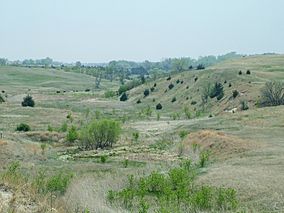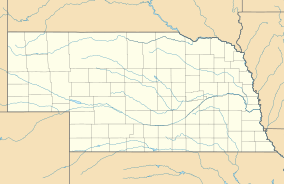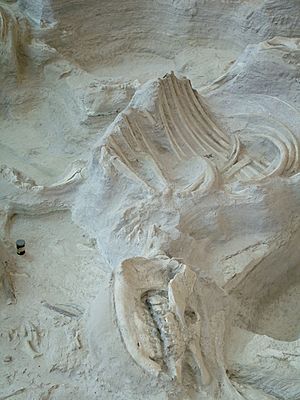Ashfall Fossil Beds facts for kids
Quick facts for kids Ashfall Fossil BedsState Historical Park |
|
|---|---|

Hills surrounding the fossil beds
|
|
| Location | Antelope County, Nebraska, United States |
| Nearest town | Royal, Nebraska |
| Area | 360 acres (150 ha) |
| Elevation | 1,722 ft (525 m) |
| Designation | Nebraska state historical park |
| Established | 1986 |
| Operator | University of Nebraska–Lincoln |
| Website | Ashfall Fossil Beds State Historical Park |
| Designated: | 2006 |
The Ashfall Fossil Beds in northeastern Nebraska is a super cool place where you can see amazing fossils. It's like a giant time capsule! This special site holds a "snapshot" of ancient life, showing many different animals exactly as they were millions of years ago.
About 10 to 12 million years ago, a huge Yellowstone hotspot volcano erupted. It covered this area with up to a foot of ash. This ash buried and preserved the animals, creating these incredible fossil beds.
Today, the site is protected as the Ashfall Fossil Beds State Historical Park. It's a 360-acre (150 ha) park with a visitor center. You can see displays and even watch scientists working in a fossil lab. There's also a special building called the Hubbard Rhino Barn. Here, you can see real fossils of ancient, hippo-like rhinos called Teleoceras and early horses, right where they were found!
The Ashfall Fossil Beds are famous for their well-preserved mammals from the middle Miocene time period. These fossils are found within the Ash Hollow Formation.
Contents
What Happened at Ashfall?
Imagine a huge volcanic eruption, not in Nebraska, but nearly 1,000 miles (1,600 km) away in what is now Idaho! This was the Bruneau-Jarbidge supervolcano. Around 12 million years ago, this volcano erupted, sending a thick cloud of ash high into the sky.
The ash then drifted downwind and settled over this area in Nebraska. Many ancient animals, like Teleoceras rhinos, small three-toed horses, camels, and birds, had gathered at a waterhole. They were looking for relief, but the falling ash became deadly.
How the Animals Died
The animals breathed in the volcanic ash, which damaged their lungs. Smaller animals with smaller lungs died first. Larger animals, like the rhinos, lasted longer but eventually also died from lung failure.
Scientists have found many perfectly preserved fossils. Some rhinos still have their bones connected, and one even has an unborn baby inside! You can also see what some animals ate for their last meal.
After the animals died, some local predators, like the bone-crunching dog Aelurodon, scavenged on the bodies. However, no predator fossils have been found at the site yet.
A Look at Ancient Nebraska
The fossils also tell us about the environment back then. The area was a savanna, with grasslands and scattered trees. The climate was warmer and milder than it is today.
The volcanic ash piled up quickly, especially in low spots like the waterhole. It stayed soft enough to preserve the animals in 3D. Even delicate bird bones and turtle shells were not crushed. Later, a layer of hard sandstone formed above the ash, protecting the fossils for millions of years.
Discovering the Fossil Beds
The first clue to this amazing site appeared in 1971. A scientist named Michael Voorhies from the University of Nebraska State Museum was exploring gullies on a farm. He and his wife, Jane, spotted the skull of a young rhinoceros sticking out of the ground.
This discovery led to the protection of the site. The Nebraska Game and Parks Foundation bought the land in 1986. The Ashfall Fossil Beds State Historical Park officially opened in 1991. Because of its importance, it was named a National Natural Landmark in 2006.
The Hubbard Rhino Barn
The park's Hubbard Rhino Barn opened in 2009. This huge building, 17,500-square-foot (1,630 m2), covers the main excavation site. Inside, visitors can watch paleontologists (fossil scientists) at work. They carefully dig up new discoveries exactly where the fossils were found.
Special walkways let you get a close-up view of the scientists during the summer digging season. It's a unique chance to see real science happening!
Animals Found at Ashfall
The main part of Ashfall is often called the "Rhino Barn" because so many Teleoceras rhino fossils are found there. But many other animals have been discovered too!
Here are some of the animals found at Ashfall:
- Horses: Five different types of ancient horses, including Cormohipparion and Pliohippus.
- Camels: Three kinds of ancient camels, such as Procamelus.
- Dogs: Three types of ancient dog-like animals, including Leptocyon. Evidence of a bone-crushing dog, possibly Epicyon, has also been found.
- Rhinos: The famous Teleoceras, a hippo-like rhino.
- Musk Deer: A saber-toothed musk deer called Longirostromeryx.
- Birds: Three bird species, including a crowned crane called Balearica exigua and a hawk similar to the secretarybird.
- Turtles: Three types of turtles, including a large tortoise called Hesperotestudo and a painted turtle.
See Also
- List of fossil sites




